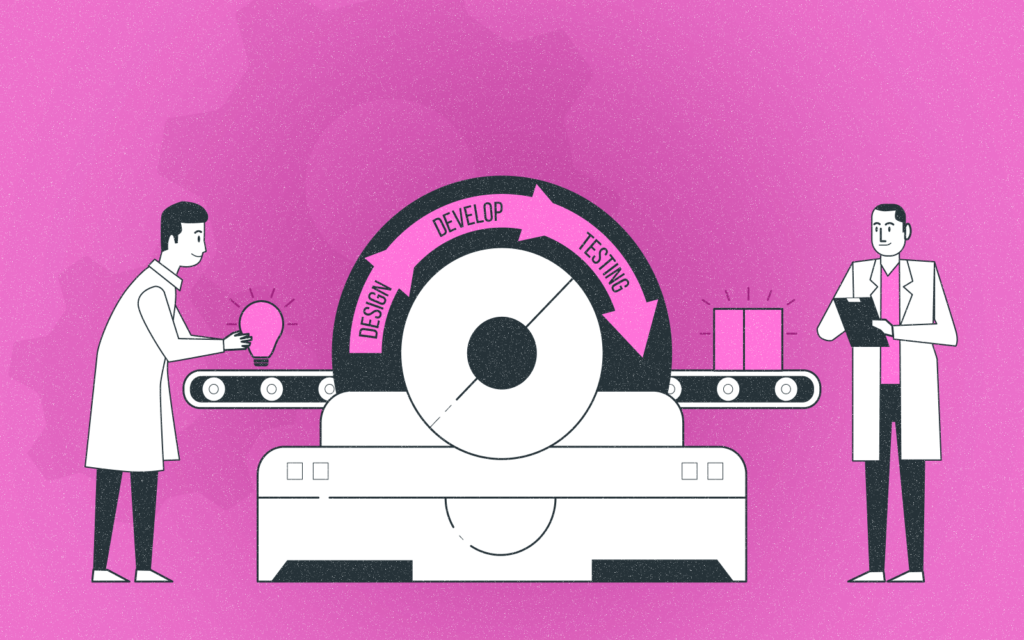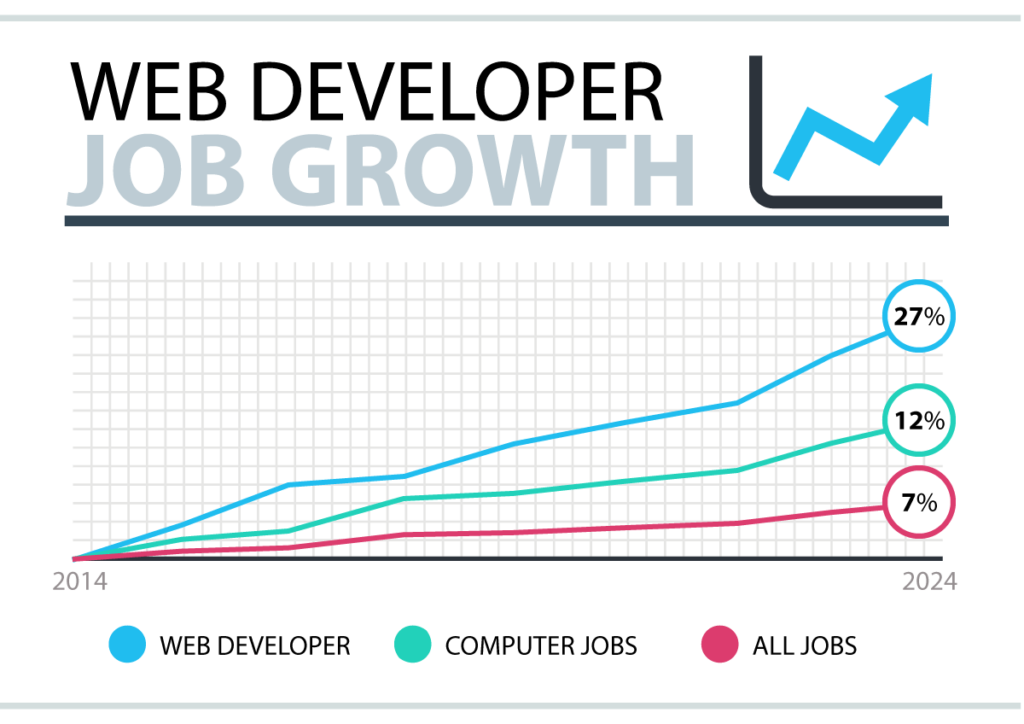How to Open a Web Development Studio

The web! The new frontier for businesses. It has never been easier to get started in web development. You don’t need to be a tech giant or have millions of dollars to invest. All you really need is a great idea, some coding skills, and a bit of elbow grease.
Starting a web development studio can be an extremely profitable business venture. However, there are a few things that you need to know to be successful. So, how do you start a web development studio?
Read on as in this blog post, we will discuss the essential steps that you need to take to start your own web development studio!

Web Development Growth
A Wild West mentality marked the early days of web development! It was the land of opportunity; anyone with an idea and some coding skills could start a web development studio and be successful.
However, those days are long gone. The web development landscape has changed dramatically in recent years, and it is now a much more competitive market. According to the U.S. Bureau of Labor Statistics, by 2024, the number of web developer jobs is expected to grow by 27%, significantly faster than the average for all occupations.

Zippia estimates there are over 241,462 web developers currently employed in the United States, of which 21.8% are women, while 78.2% are men. Yes, this is your competition!
Therefore, if you want to start a web development studio, you must be aware of the competition. However, don’t let this dissuade you! With the right skills and strategies, you can be successful in this rapidly growing industry.
Let’s review some basics first!
What’s Web Development?
Web development is the process of creating and maintaining websites. It encompasses everything from developing the website’s initial layout to adding features and functions that make it more interactive and user-friendly.
Web developers use a variety of programming languages, such as HTML, CSS, and JavaScript, to create websites that are both functional and aesthetically pleasing
When most people think of web development, they envision someone sitting in front of a computer, writing lines of code. And while coding is certainly a large part of web development, it’s not the only thing web developers do.
Web developers also have to be able to design the website’s layout, create and format content, and add features and functionality that will make the website more user-friendly. Web developers have a wide range of responsibilities!

Web Development Life Cycle
As with everything in life, web development requires following a process for a successful result! The web development life cycle is the process that web developers follow to create and maintain a website. It typically includes the following steps:
- Gathering Information: First, it is important to determine the purpose of the website and the target audience. This information can be gathered through interviews, surveys, focus groups, or other research methods. Once the purpose and audience are clear, the web developer can begin to design the website.
- Planning: During this stage, the web developer creates a plan for the website. This plan includes defining the site’s purpose, audience, and goals.
- Design: Once the planning stage is complete, the web developer creates a mockup of the website. This mockup is used to determine the layout, color scheme, and overall look and feel of the site.
- Development: In this stage, the web developer coded the website according to the specifications determined in the previous stages.
- Testing: Once the website is coded, the web developer tests it to ensure that it is functioning properly.
- Deployment: Finally, the web developer makes the website live and available to the public.

While the steps in the web development life cycle may seem straightforward, they can be quite complex and time-consuming. Be sure to know what you are getting into!
Which Services Can You Offer In Your Web Development Studio?
The services that you offer will depend on the size and scope of your studio. The most common services offered by web development studios include:
- Strategy: This is the process of planning and developing a website. It includes everything from research and analysis to creating wireframes and site maps.
- Design: This is the process of creating the visual layout for a website. It includes everything from choosing colors and fonts to designing page layouts and graphics.
- Hosting: To make a website available to the public, it must be hosted on a web server. Many studios offer web hosting services to their clients
- Development: This is the process of coding a website. It includes everything from writing HTML and CSS code to adding functionality with JavaScript.
- Website Maintenance: Once a website is live, it requires regular maintenance to ensure that it remains up-to-date and functioning properly.
These are just a few of the most common services offered by web development studios. You may also choose to offer additional services, such as e-commerce solutions, SEO, or social media. Whichever services you decide to offer, be sure that you can provide quality work that meets your client’s needs and expectations!
What You Need to Start a Web Development Studio
Now that you know a little bit more about web development studios, you may be wondering what you need to start your own studio. While there is no one-size-fits-all answer to this question, there are a few key things that you will need:
Step One: Market Research Your Idea
As with any business, it is important to do your research before starting a web development studio. This includes understanding the needs of your target market and what they are looking for in a web development studio. To accomplish this, it is important to create a market research plan.
This research will help you determine if there is a market for your services and if there is enough demand to sustain your business
This plan will help you to understand the needs of your target market and to develop a viable business model. To begin, you will need to:
- Identify your target market. Are you targeting small businesses, individuals, or both?
- Research their web development needs. What kind of services are they looking for? How much are they willing to pay?
Be sure to also research your competition and understand what sets you apart from them
Once you have a good understanding of the needs of your target market, you can start to develop a business model that will allow you to meet those needs.
Get more out of your business
Get the best employee engagement content every week via mailing list
Step Two: Develop a Business Plan
Once you have done your research and you are ready to move forward with starting your studio, the next step is to develop a business plan. This document will outline your goals, strategies, and financial forecast for the next three to five years.
For a web development studio, some key elements to include in your business plan are an overview of the web development industry, a market analysis of your target clients, and a detailed marketing plan. Additionally, you will need to create a financial forecast that outlines your start-up costs, ongoing expenses, and expected revenue.
For example, look at this web design business plan one-page template!

Step Three: Choose Your Services
Now that you have done your research and you have a business plan in place, it is time to start thinking about the services that you will offer.
Deciding what services to offer is one of the most important aspects of opening a web development studio. After all, the services you offer will determine the types of clients you attract and the projects you work on!
For example, if you’re primarily focused on web development, you could add web design or digital marketing to your repertoire. You may also choose to offer additional services such as e-commerce solutions or SEO.
Ultimately, the key is to choose services that complement each other and allow you to provide a well-rounded experience for your clients.
Step Four: Find the Right Tools and Resources
To run a successful web development studio, you will need to have the right tools and resources in place. This includes everything from project management software to accounting tools.
Some essential tools for web developers include:
- A code editor: This is the program that you will use to write and edit your code. Some popular options include Atom, Sublime Text, and Visual Studio Code.
- A version control system: This tool allows you to track changes to your code and revert to older versions if necessary. Git is a popular option for version control.
- A task manager: This tool helps you keep track of tasks and deadlines so that you can stay organized and on schedule. Asana and Trello are two popular options for task management.
In addition to these tools, you will also need to have a strong understanding of the latest web development trends and technologies.
Keeping up with the latest industry news is crucial for staying ahead of the competition. You can do this by following industry-leading blogs and subscribing to newsletters.
Step Five: Hire a Team of Professionals
If you want your studio to be successful, it is important to hire a team of qualified professionals. When hiring developers, be sure to look for individuals who are knowledgeable about the latest technologies and trends.
Additionally, it is important to find developers who can work well in a team environment
In addition to developers, you will also need to hire designers, project managers, and support staff. Be sure to take the time to interview each candidate thoroughly so that you can find the best fit for your studio”
Step Six: Create a Good Website
Any web development studio worth its salt will tell you that one of the most important aspects of any good website is its design. However, with so many web development studios out there, how can you make sure that yours stands out from the rest?
Here are a few tips:
- Keep it simple: A good web design is all about simplicity. Resist the urge to cram too much information onto each page.
- Make it responsive: In today’s world, more and more people are using their mobile devices to browse the web. As a result, your website must be responsive, meaning that it looks just as good on a phone or tablet as it does on a desktop computer.
- Pay attention to detail: The little things can make a big difference when it comes to web design. Be sure to proofread your content and double-check your links before launching your site.

When you have your website up and running, make sure to add an online portfolio. Your portfolio should showcase your best work and highlight the services that you offer. Be sure to include testimonials from satisfied clients so that potential customers can see your past references.
Once you have a strong website in place, it’s time to start promoting your studio!
Step Seven: Promote Your Services
Now that your web development studio is up and running, it’s time to start promoting your business! There are several ways to do this, including content marketing, search engine optimization, and social media marketing.
In an effective content marketing strategy, you will need to produce high-quality blog posts, infographics, and other types of content that will interest your target audience
In addition to creating great content, you will also need to make sure that your website is easy to find by potential clients.
Finally, don’t forget the power of word-of-mouth advertising. Be sure to let your clients know that you appreciate their business and encourage them to spread the word about your studio!
Takeaway
Starting a web development studio is a great way to tap into the growing demand for web development services. However, there are a few things you need to keep in mind if you want your business to be successful.
Be sure to develop a strong branding strategy, find your niche market, and invest in marketing and promotion. If you do all of this, you’ll be well on your way to building a successful web development studio!
Do you want to start a web development studio? Follow these seven steps and you’ll be on your way to success! Our best wishes.
-The Monitask Team


